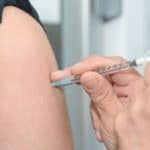1. Based on the study, there is a small absolute risk for shoulder conditions after vaccination.
2. Simultaneous administration of vaccines was associated with a higher risk for shoulder conditions among the elderly.
Evidence Rating Level: 2 (Good)
Study Rundown: There have been previous reports of shoulder injuries related to vaccine administration, such as deltoid bursitis. In fact, the National Vaccine Injury Compensation Program listed that there was a causal relationship between vaccine injection and deltoid bursitis. However, there have been no population-based studies that examine the risk of shoulder conditions after vaccination. Therefore, there is a gap in knowledge as to understanding the risk for shoulder conditions after intramuscular vaccination and any possible risk factors. This study found that there is a small absolute risk for shoulder conditions after vaccination. This study was limited by factors such as generalizability to other health care settings, the use of administrative data, and residual confounding. Nevertheless, these study’s findings are significant, as they demonstrate that after vaccination, there exists a small absolute risk for shoulder conditions.
Click to read the study in AIM
Relevant Reading: Risk for Subdeltoid Bursitis After Influenza Vaccination
In-Depth [retrospective cohort study]: This retrospective cohort study utilized Kaiser Permanente Southern California (KPSC) members. Patients who were aged 3 years or older and received at least 1 intramuscular vaccine injected in an arm at a KPSC facility between April 2016 and December 2017 were eligible for the study. Patients who had another intramuscular injection in the same arm within postvaccination days 1 and 180, as well as those who were not continuously enrolled in the KPSC health plan in the 180 days before and after the index date, were excluded from the study. The primary outcome measured was the presence of a shoulder condition after vaccination with onset within the first 7 days of vaccination, with symptoms lasting for more than 30 days. Outcomes in the primary analysis were assessed via a natural language processing algorithm and manually confirmed via their chart. Based on the analysis, there were 371 cases of shoulder condition among 3,758,764 administered vaccinations, with an estimated incidence of 0.99 (95% Confidence Interval [CI], 0.89 to 1.09) per 10000 vaccinations. When stratified on age, the incidence was 1.22 (95% CI, 1.1 to 1.35) for adults aged greater than or equal to 18 years, and 0.05 (95% CI, 0.02 to 0.14) for the pediatric population (age 3 to 17). Among the adult vaccinated population, factors such as advanced age, female sex, an increased number of outpatient visits in the 6 months before vaccination, and pneumococcal conjugate vaccine were associated with a higher risk for shoulder conditions. Simultaneous administration of vaccines was also associated with a higher risk for shoulder conditions among elderly persons. Overall, this study demonstrated that there was a small absolute risk for shoulder conditions after vaccination, and suggest that needle over-penetration may be a part of the causal pathway, though more research is needed to better understand the risk factors and causal pathways for shoulder conditions after vaccination.
Image: PD
©2022 2 Minute Medicine, Inc. All rights reserved. No works may be reproduced without expressed written consent from 2 Minute Medicine, Inc. Inquire about licensing here. No article should be construed as medical advice and is not intended as such by the authors or by 2 Minute Medicine, Inc.


